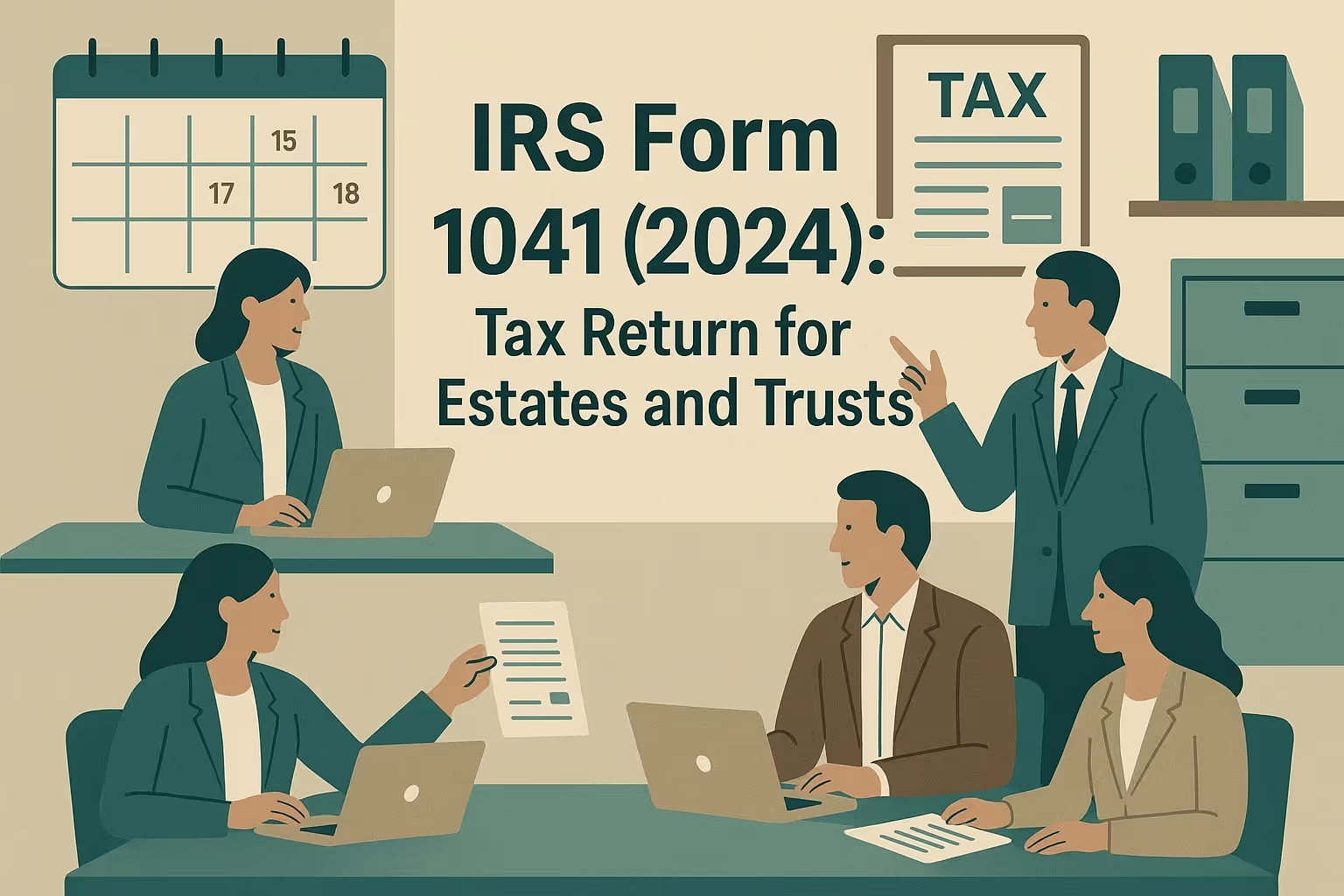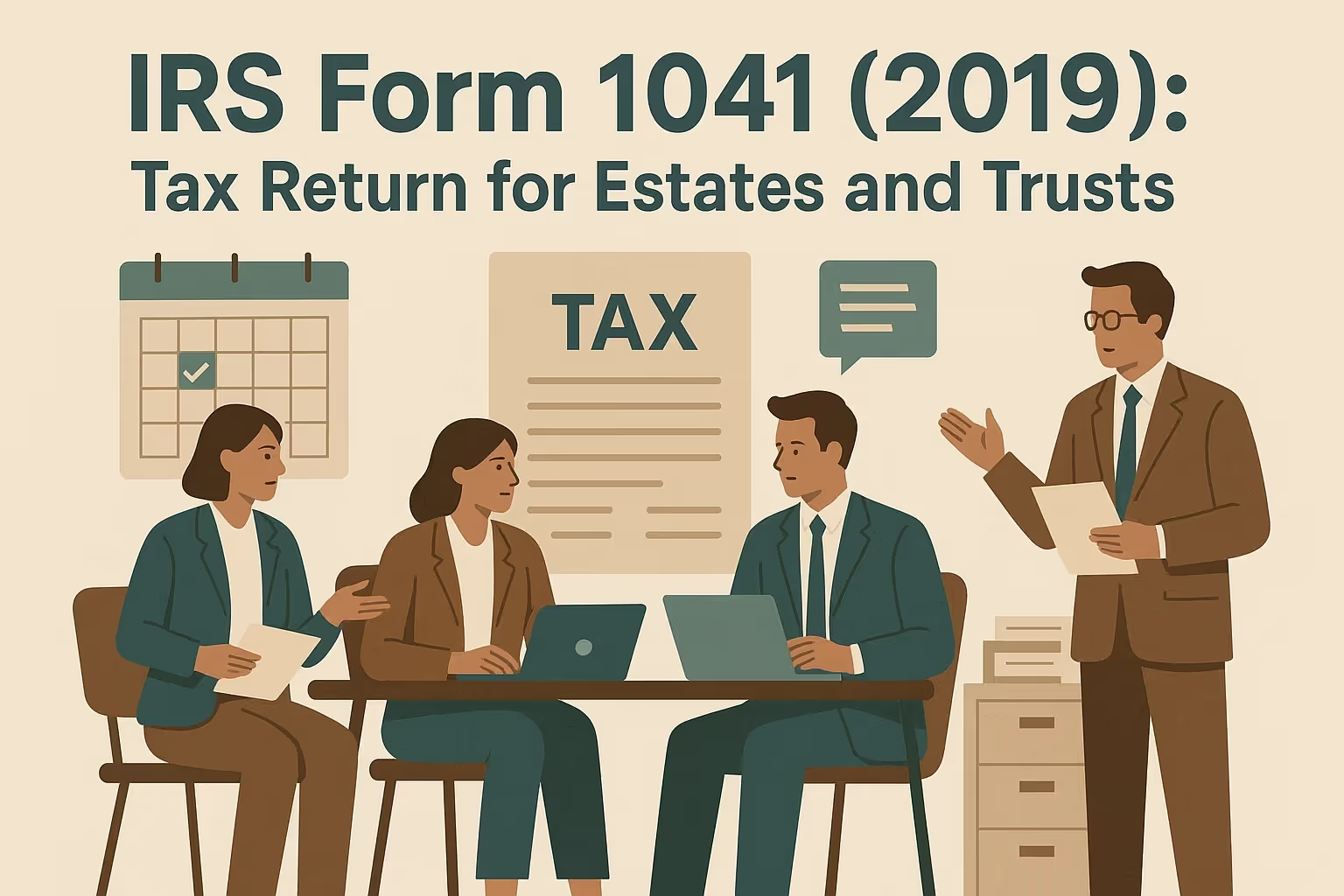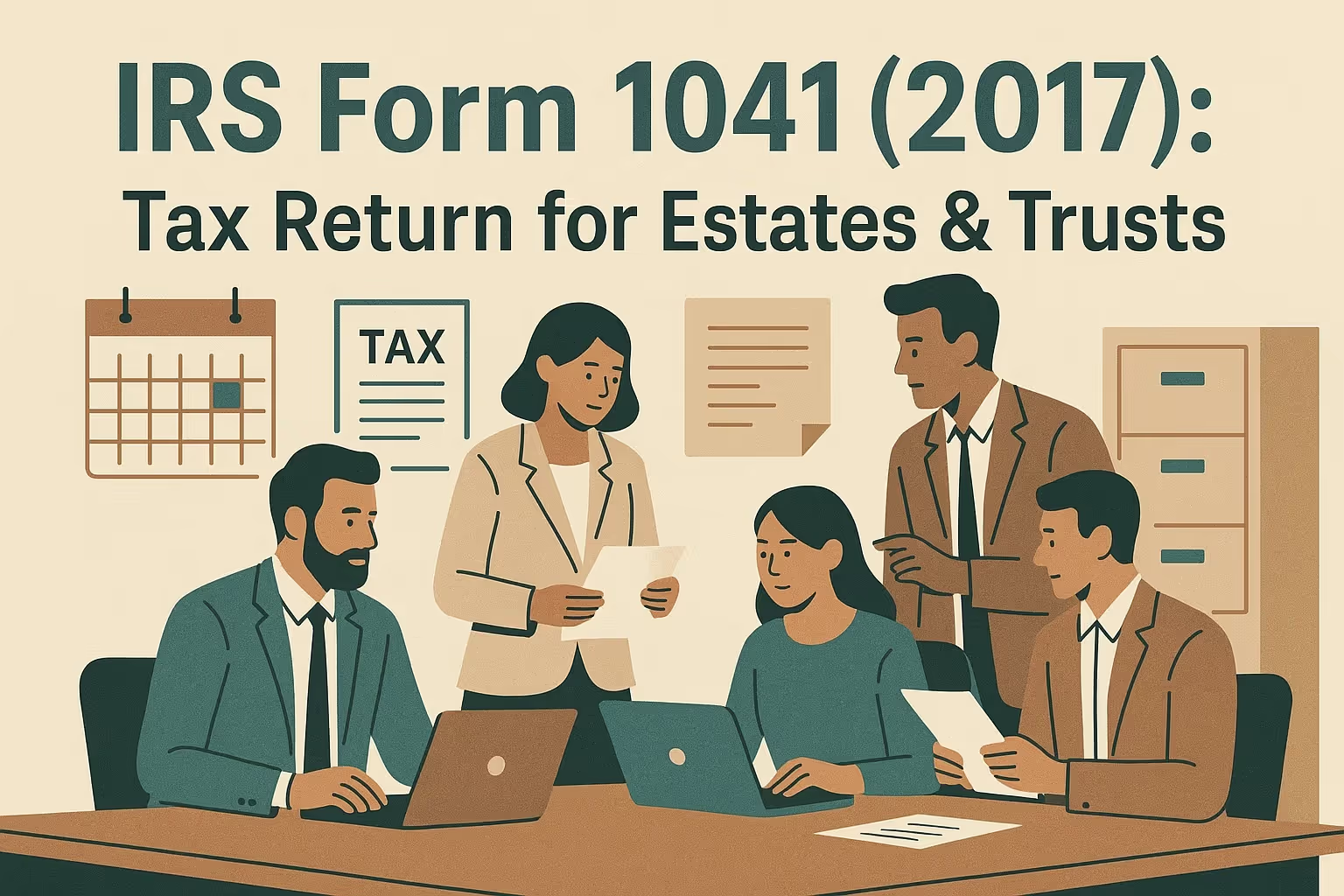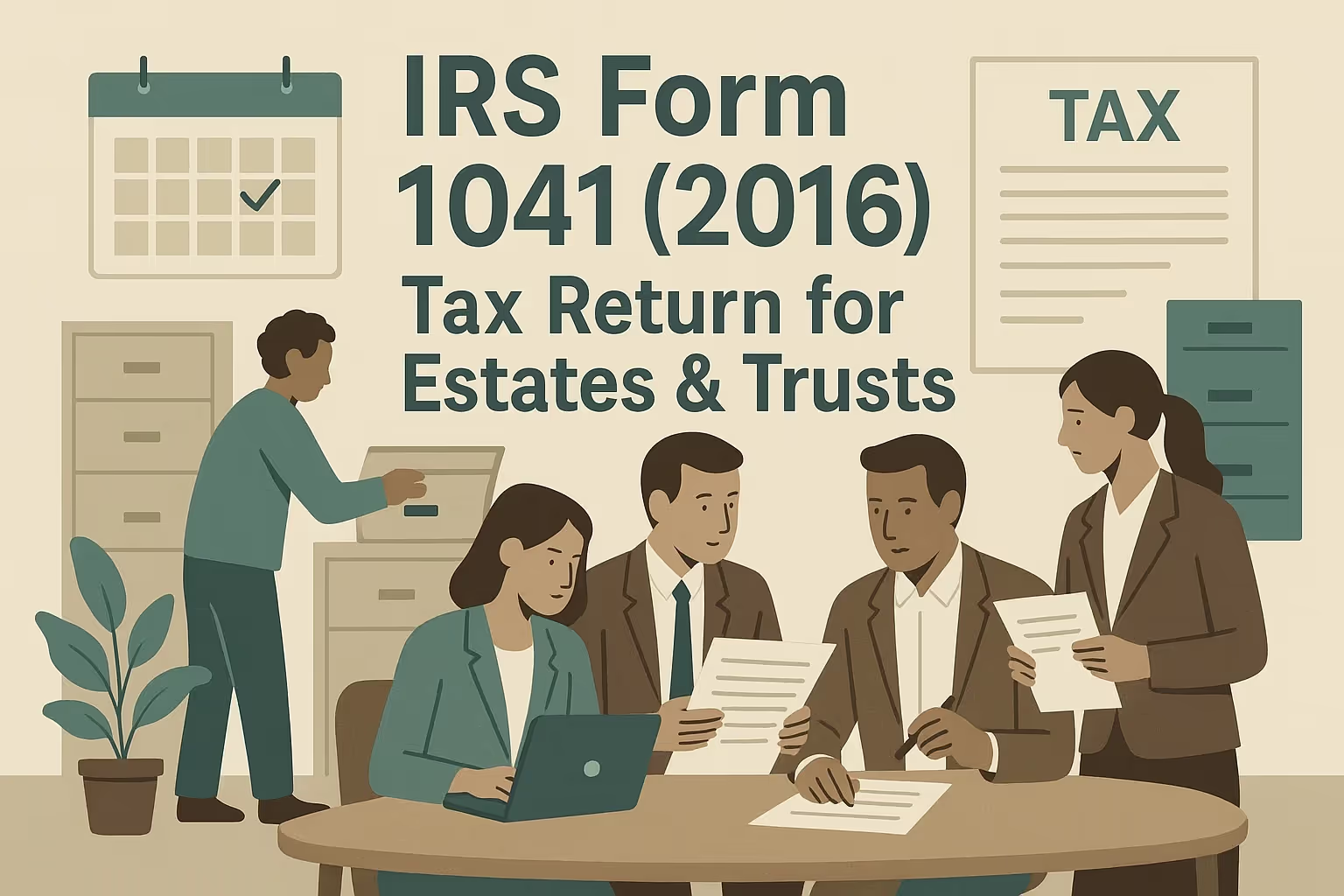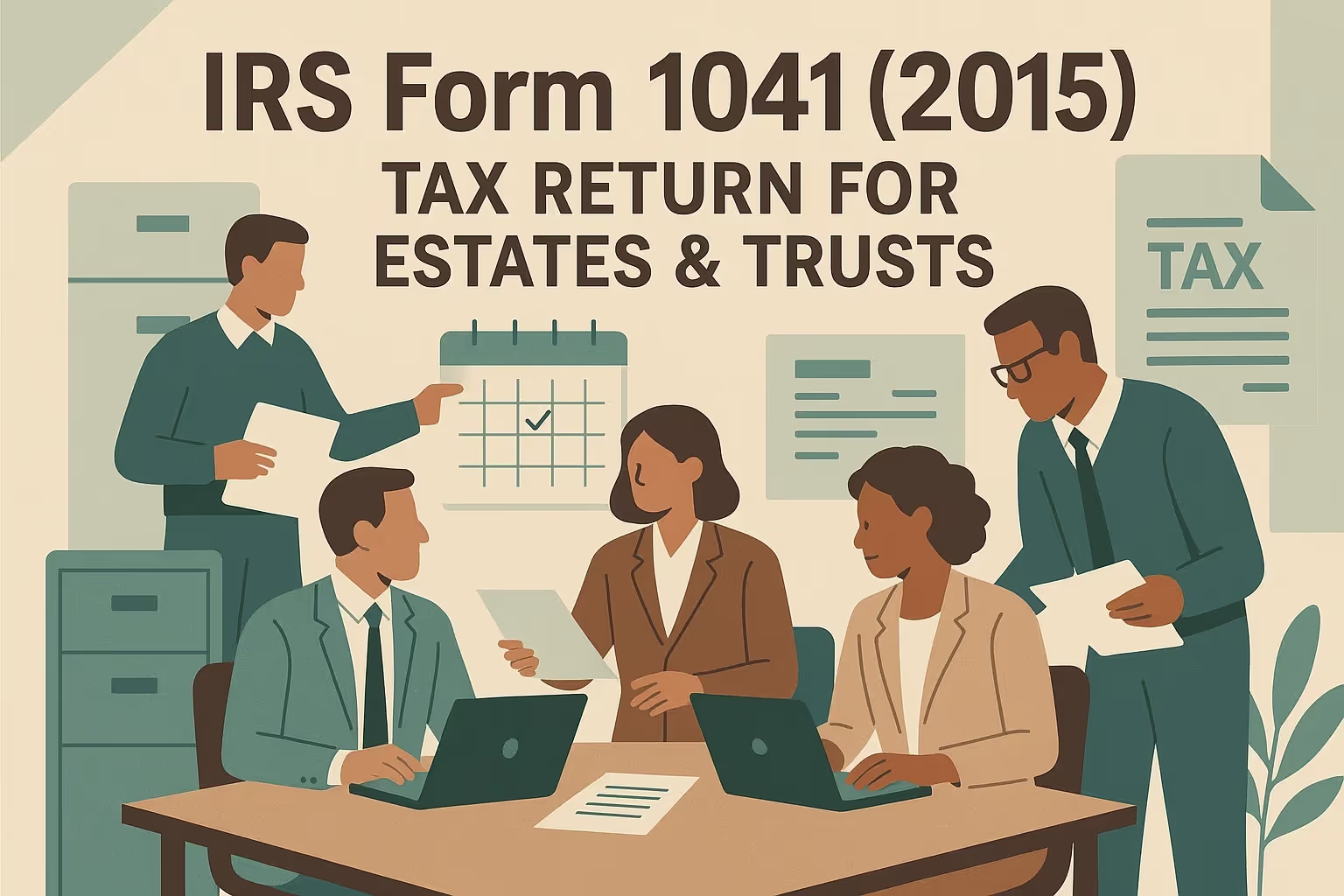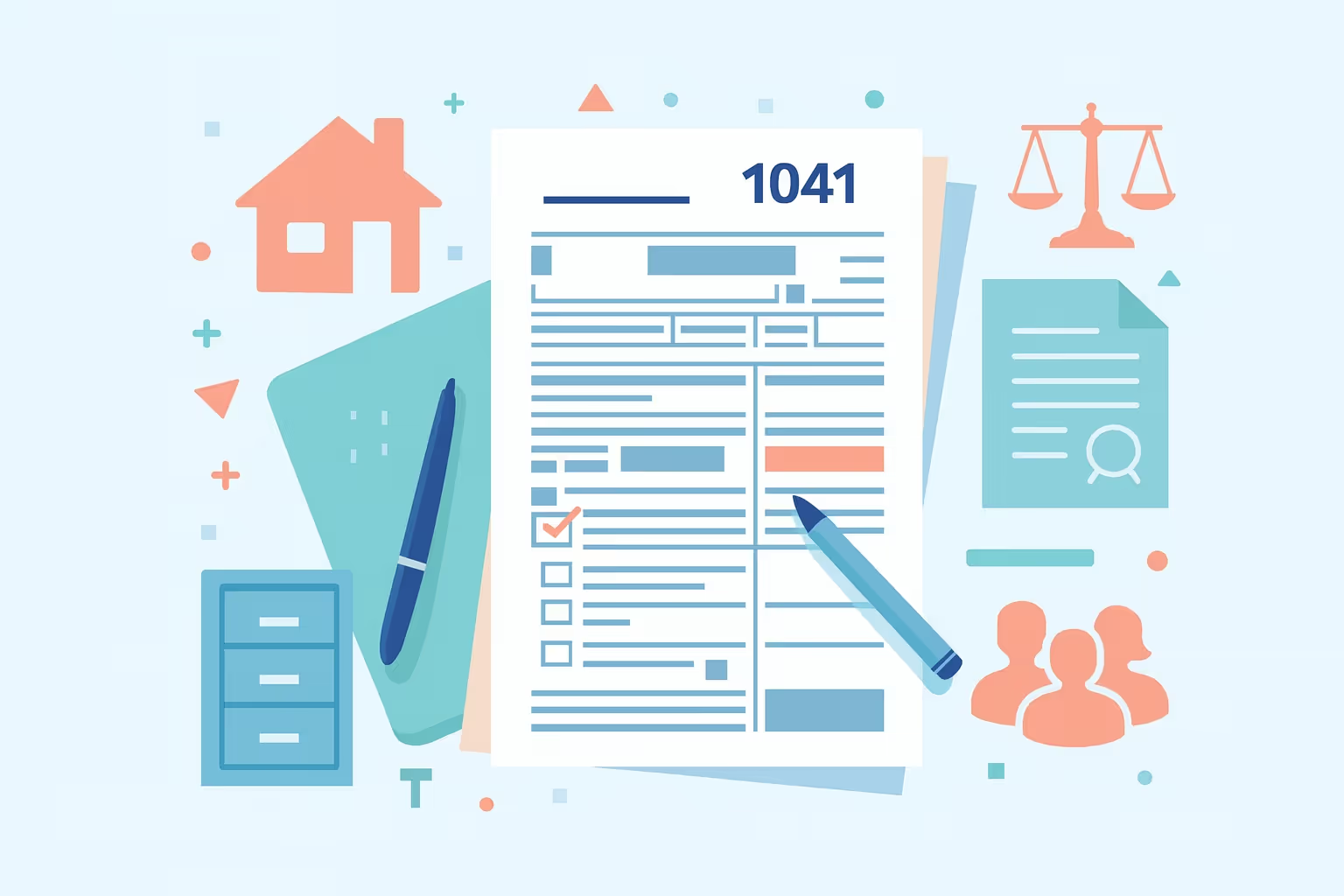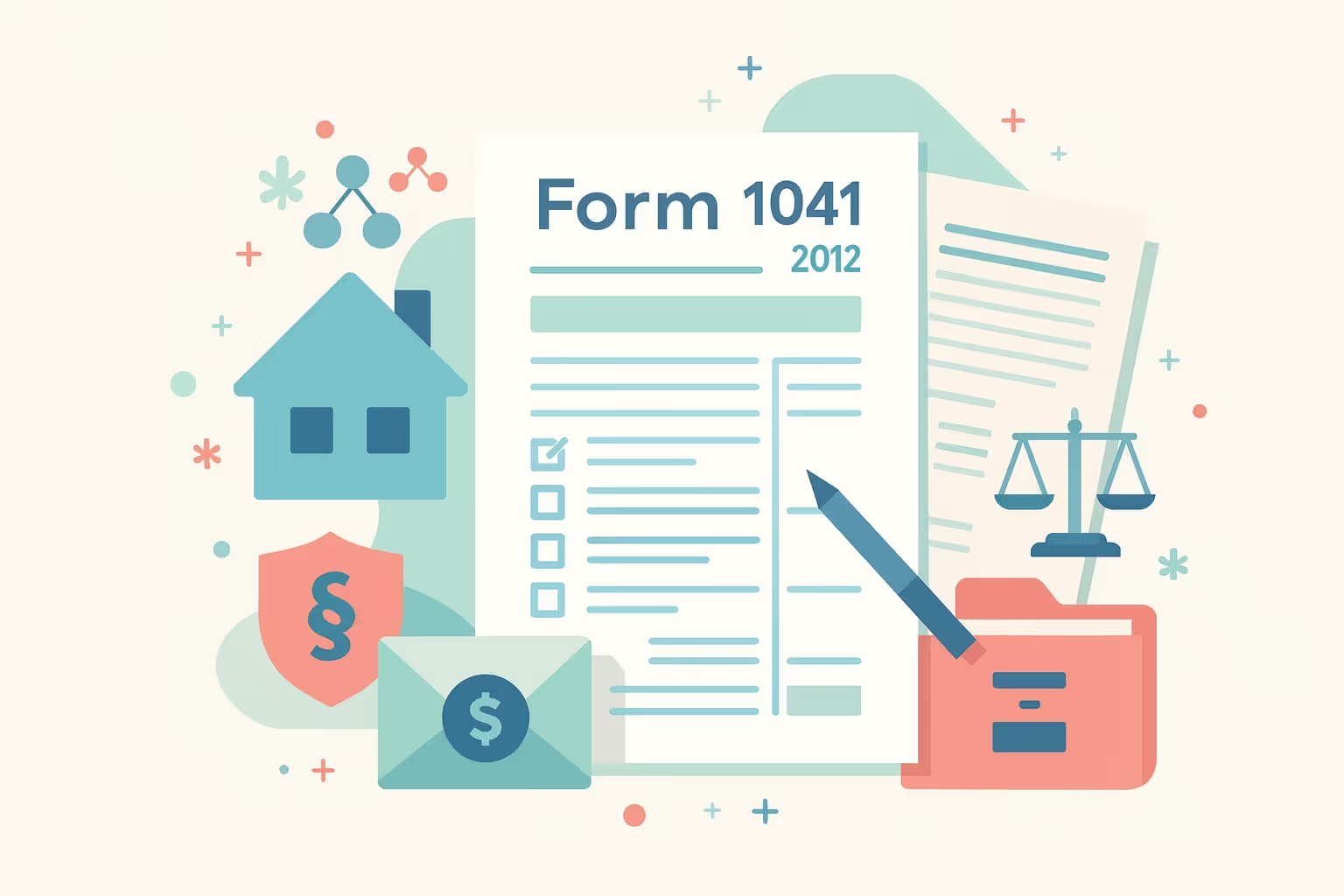Form 1041 2011 Instructions: Estate and Trust Tax Return
Form 1041 is the federal return the Internal Revenue Service requires for estates and trusts during tax year 2011. It is the official document for reporting income earned, deductions claimed, and distributions made to beneficiaries. Fiduciaries, including executors, trustees, and personal representatives, must file this federal income tax return to comply with the Internal Revenue Code. The filing process determines the estate’s or trust’s income tax liability and appropriately allocates distributed income for federal income tax purposes. Each return defines the entity as separate from the deceased person's estate or individual taxpayer.
A fiduciary income tax return is necessary when an estate or trust earns income from wages, mutual funds, savings accounts, or other income-producing assets, including interest-bearing accounts, bonds, or rental properties. Estates must report income generated after the decedent’s death, while trusts record ongoing income taxation throughout the estate’s tax year. The form calculates total income, allowable deductions, and the income distribution deduction before determining the portion of income taxed to beneficiaries.
Because these requirements apply only to the 2011 tax year, fiduciaries should verify every threshold and schedule. The IRS offers guidance on reporting rules, due dates, and documentation requirements in its Form 1041 Instructions for 2011.
Understanding the Fiduciary Income Tax Return (Form 1041)
The fiduciary income tax return, or Form 1041, applies to estates and trusts that are required to report income, deductions, gains, losses, and distributions to the Internal Revenue Service. It is the primary document for identifying how an estate or trust generates income, calculates income tax liability, and distributes taxable amounts to beneficiaries. This return identifies the estate or trust as a separate legal entity for federal income tax purposes, ensuring transparent reporting between fiduciaries, beneficiaries, and the IRS.
Who Must File a Fiduciary Income Tax Return
- Decedent’s Estate: A decedent’s estate must file when the annual gross income equals or exceeds $600, or when the estate includes a nonresident alien beneficiary. The personal representative must file the return and report income earned after the decedent’s death.
- Domestic Estate or Trust: A domestic estate or trust must submit Form 1041 if it earns taxable income, generates income from qualified investments, or distributes income during the tax year.
- Foreign Estate or Foreign Trust: A foreign estate or foreign trust is subject to special reporting under the Internal Revenue Code when it manages income sourced from a foreign country or involves nonresident beneficiaries.
- Grantor Trust: A grantor trust generally reports income on the grantor’s personal income tax return but may require Form 1041 for record-keeping or compliance.
What Are the Fiduciary Return Reports
- Income Earned: This report includes income produced by savings accounts, mutual funds, rental properties, and qualified opportunity funds.
- Income Taxation: The return identifies which portions of income are taxed at the entity level versus passed to beneficiaries.
- Deductions and Credits: The return reflects allowable deductions for fiduciary fees, charitable distributions, and other expenses permitted under the Internal Revenue Code.
- Income Distribution Deduction: The income distribution deduction determines whether distributed income reduces the estate’s taxable income.
- Tax Year and Accounting: The return indicates whether the entity uses a fiscal year or a calendar year for its accounting purposes.
Fiduciaries use Form 1041 to meet federal income tax requirements and accurately report estate or trust activity. Correct filing ensures each beneficiary’s share of taxable income is transparent for federal income tax return purposes and helps avoid errors in allocating distributions.
Key 2011 Updates Under the Internal Revenue Code
Several updates introduced in tax year 2011 affected how fiduciaries prepared the fiduciary income tax return for estates and trusts. These updates covered filing thresholds, exemption limits, and valuation rules for property received after a decedent’s death. Understanding each change ensures accurate income taxation and compliance with federal reporting requirements under the Internal Revenue Code.
Bankruptcy Estate Filing Threshold Increase
For tax years beginning in 2011, the annual gross income threshold for bankruptcy estates rose to $9,500. This update impacted fiduciaries overseeing Chapter 7 or Chapter 11 bankruptcy cases involving a decedent’s estate or trust.
Entities meeting or exceeding this threshold were required to file a fiduciary income tax return. The revision aligned bankruptcy estate reporting with broader income tax return filing standards, improving consistency across separate legal entities.
Qualified Disability Trust Exemption Adjustment
A qualified disability trust could claim an exemption of up to $3,700 for 2011, an increase from previous years. The exemption was no longer subject to income-based phaseouts, allowing full utilization regardless of total income earned. Fiduciaries administering these trusts benefited from more precise exemption calculations and more predictable income tax liability outcomes.
Basis Determination for Estate Assets
For decedents who passed away in 2011, Congress repealed the special election permitting modified carryover basis rules under section 1022. Estates were required to use the property's fair market value at the decedent’s death for federal income tax purposes. This revision simplified record-keeping for personal representatives managing large estates and ensured uniform valuation under the Internal Revenue Code.
Clarifications for Entity Reporting
Form 1041 entity selection boxes were revised to improve accuracy when identifying charitable and split-interest trusts. The continuation of elective deductions for state and local sales taxes instead of income taxes was also reaffirmed for 2011.
These changes strengthened reporting consistency across estate and trust entities while simplifying how fiduciaries calculated exemptions, income distribution deductions, and estate tax return values.
Staying aware of such updates ensures that fiduciaries accurately reflect current regulations in every filing. A clear grasp of these updates also provides the foundation for precise compliance and effective tax administration.
Pre-Filing Preparation and Employer Identification Number (EIN) Setup
Before filing a fiduciary income tax return, fiduciaries must complete key administrative steps to ensure compliance with the Internal Revenue Code. Estates and trusts are treated as separate legal entities for federal income tax purposes, which requires obtaining an Employer Identification Number (EIN).
This number distinguishes the estate or trust from the deceased person’s Social Security number, allowing for accurate reporting of income earned, deductions, and distributions. Without an EIN, the fiduciary cannot file returns or make payments. This number is crucial for fulfilling all obligations under federal income tax rules.
Adequate preparation begins with gathering financial records that reflect all income earned and deductible expenses. Fiduciaries should collect bank statements, investment summaries, wage reports, and records of mutual funds and savings accounts. Supporting documents must include receipts for fiduciary fees, charitable contributions, and allowable funeral expenses.
Estates must report income generated after the decedent’s death, while trusts must include ongoing income earned within the estate’s tax year. Proper organization prevents errors in calculating total income, credits, and the income distribution deduction, ensuring that distributions taxed to beneficiaries are reported correctly.
The next step is selecting the appropriate filing year. A domestic estate may adopt a fiscal tax year before the decedent’s death, while most trusts must use a calendar year. Choosing the correct reporting period ensures the timely filing of all required tax forms. The IRS provides a step-by-step guide on its How to Apply for an EIN page, which helps fiduciaries establish the entity’s identification before submitting Form 1041.
Step-by-Step Process to File Form 1041
Filing Form 1041 for tax year 2011 requires careful organization and a structured approach to ensure compliance with the Internal Revenue Code. Each step must be completed sequentially to accurately report income earned, deductions taken, and beneficiary distributions.
The fiduciary income tax return outlines the estate or trust’s financial activity and ensures income taxation aligns with federal income tax purposes. Following a methodical process reduces the risk of filing errors and helps fiduciaries meet all reporting obligations.
Step 1: Enter Identifying Information
Begin with the return’s header. Enter the legal name of the estate or trust, mailing address, Employer Identification Number (EIN), and the fiduciary’s name and title. Identify whether the entity is a decedent’s estate, domestic trust, foreign trust, or grantor trust. Specify the entity’s filing period, selecting either a calendar or fiscal tax year. This foundational information ensures the Internal Revenue Service can accurately process the fiduciary income tax return.
Step 2: Report Total Income
List all sources of income generated during the estate’s tax year. Include interest from savings accounts, dividends from mutual funds, business earnings, and gains from qualified investments. Add rental income, royalties, or any wages paid to the estate or trust. The total income figure forms the basis for subsequent deductions, exemptions, and the calculation of taxable income.
Step 3: Claim Allowable Deductions
Deduct eligible expenses associated with managing the estate or trust. Examples include fiduciary fees, attorney or accountant charges, charitable donations, and certain administrative costs. Include allowable deductions for state and local taxes, investment interest, and funeral expenses. Document each deduction to substantiate the claimed amount and to reduce potential income tax liability.
Step 4: Determine the Income Distribution Deduction
The income distribution deduction determines how much income is distributed to beneficiaries, offsetting taxable income retained within the estate or trust. Complete Schedule B to calculate the distributable net income, which ensures income taxation is properly assigned between the entity and its beneficiaries. Accurate computation prevents double taxation and promotes transparency in reporting.
Step 5: Calculate Taxable Income and Credits
Subtract all deductions and exemptions from total income to determine taxable income. Apply applicable tax credits, such as foreign tax credits or credits for the previous year's minimum tax. Estates and trusts with qualified opportunity fund investments or other specialized holdings must ensure all credits align with federal income tax return requirements.
Step 6: Complete Required Schedules and Forms
Attach all necessary schedules that apply to the entity’s activities.
- Schedule A: Reports charitable deductions claimed by the estate or trust.
- Schedule B: Calculates the income distribution deduction to allocate income among beneficiaries.
- Schedule D: Records capital gains and losses realized during the tax year.
- Schedule G: Documents the entity’s tax computation and payments.
- Schedule K-1: Outlines each beneficiary’s share of income, deductions, and credits.
Each schedule must correspond with figures reported on Form 1041. For proper income and deduction allocation, include copies of all beneficiary Schedules K-1.
Step 7: Review, Sign, and Submit
Review all entries for accuracy and completeness. Confirm that the Employer Identification Number, names, and dollar amounts match the supporting documents. The fiduciary and any paid preparer must sign and date the return. Maintain copies of all filed documents for the entity’s permanent records.
Completing Form 1041 with precision ensures the estate or trust meets its federal obligations. These steps promote accurate reporting, proper income allocation, and compliance with fiduciary requirements.
Filing Methods and Personal Income Tax Return Deadlines
Fiduciaries filing Form 1041 for tax year 2011 must select an appropriate submission method and ensure timely compliance with Internal Revenue Service deadlines. Each estate or trust must follow the filing schedule based on its designated tax year, whether calendar or fiscal. Understanding these deadlines and methods helps prevent processing delays and supports accurate reporting of income earned, deductions claimed, and distributions taxed under federal income tax purposes.
Filing Methods
Fiduciaries have the option to choose between electronic filing and traditional paper submission. Each filing method must include all required schedules for income distribution deduction, total income calculation, and estate tax computations.
- Electronic Filing (E-File): E-filing ensures faster processing and immediate confirmation of receipt. Fiduciaries must use IRS-approved software, including Form 8453-F or Form 8879-F for signature authorization. Fiduciaries must transmit electronic submissions before midnight on the filing deadline.
- Paper Filing: Estates and trusts may file by mail when electronic submission is unavailable. Each return must include original signatures from the fiduciary and any paid preparer. All supporting schedules and Forms K-1 must be attached, with pages assembled in the order specified by the IRS.
- Record-keeping: Keep stamped mailing receipts or electronic confirmations for at least three years. Organizing records supports future verification of reported income, distributions, and taxable income adjustments.
Filing Deadlines
- Calendar-Year Filers: April 17, 2012
- Fiscal-Year Filers: 15th day of the fourth month after the fiscal year closes
- Extensions: Use Form 7004 to request an extension of time before the due date.
The U.S. Department of the Treasury provides an official resource through the EFTPS Portal to facilitate timely electronic tax payments and verification. Fiduciaries using the Electronic Federal Tax Payment System (EFTPS) can schedule payments in advance and receive confirmation of completed transactions.
Meeting deadlines ensures that estates and trusts fulfill all obligations under federal income tax return requirements. Consistent adherence to filing rules supports compliance with the Internal Revenue Code and preserves the entity’s good standing with the Internal Revenue Service. Proactive management of filing timelines helps fiduciaries avoid delays and maintain accuracy across all tax years.
Paying Income Tax and Estimated Income Tax Obligations
Fiduciaries must ensure that every income tax payment for an estate or trust is timely and accurately recorded. Paying income tax through authorized methods helps maintain compliance with the Internal Revenue Code and ensures proper crediting toward the estate’s or trust’s account.
Each technique aligns with the fiduciary’s preferences for filing federal income tax returns. Understanding these options enables fiduciaries to plan payments, minimize errors, and maintain comprehensive documentation for income tax purposes.
- Direct Debit Authorization for E-Filed Returns: Fiduciaries submitting an electronic return may authorize a direct debit from a verified bank account. The payment is scheduled during e-filing and must match the Employer Identification Number and tax year reported on the return.
Direct debit is a secure and efficient method that automatically processes on the selected date. Maintaining confirmation records ensures the payment appears in the entity’s tax account.
- Check or Money Order with Form 1041-V: Paper filers may submit a check or money order payable to “United States Treasury.” Form 1041-V must accompany the payment to ensure proper posting to the correct fiduciary income tax return.
The memo line should include the entity’s name, Employer Identification Number, and “Form 1041.” Copies of the check and voucher must be retained for tax payment and year-end reconciliation.
- Electronic Federal Tax Payment System (EFTPS): Fiduciaries can remit one-time or recurring payments for current or estimated income tax using EFTPS. The platform issues electronic receipts, ensuring transparency and verifiable records for every transaction. EFTPS is ideal for estates or trusts that generate income throughout the year and need predictable scheduling.
- Quarterly Estimated Income Tax Installments: Estates and trusts anticipating substantial income earned across multiple periods must submit quarterly estimated income tax payments. The standard due dates are April 15, June 15, September 15, and January 15 of the following year. Making timely installments reduces year-end tax balances and prevents additional interest charges.
Effective management of each payment method ensures compliance, supports accuracy, and demonstrates responsible fiduciary administration. Establishing a structured payment schedule reinforces fiscal accountability across each filing period. Consistent documentation enables fiduciaries to monitor annual cash flow and enhance oversight of tax obligations.
Avoiding Common Income Tax Filing Errors
Fiduciaries preparing Form 1041 for tax year 2011 must review every entry carefully to ensure accuracy and compliance with the Internal Revenue Code. Errors in income reporting, deduction claims, or beneficiary allocations may delay processing and lead to unnecessary correspondence from the Internal Revenue Service.
Maintaining organized records and verifying figures against supporting schedules helps reduce discrepancies and accurately calculate taxable income. The table below identifies the most frequent filing mistakes, their impact on the fiduciary income tax return, and best practices for prevention.
- Incorrect Entity Classification
- Explanation: Selecting the wrong entity type (e.g., marking an estate instead of a trust) can cause misapplied exemption amounts and incorrect filing requirements.
- Prevention Tip: Confirm the entity type under the governing document before marking Form 1041. Review definitions for domestic estate, complex trust, and grantor trust.
- Missing Employer Identification Number (EIN)
- Explanation: Using a fiduciary’s SSN instead of an EIN causes ID mismatches and delays.
- Prevention Tip: Obtain and verify the correct EIN before filing. Ensure consistency across all schedules and vouchers.
- Omitted Tax-Exempt Income
- Explanation: Leaving out tax-exempt income leads to inaccurate DNI and income distribution deduction calculations.
- Prevention Tip: Include all income—taxable and tax-exempt—in Schedule B computations.
- Improper Allocation of Income
- Explanation: Allocating income incorrectly between the estate and beneficiaries distorts what is taxed at the individual level.
- Prevention Tip: Match income distribution deduction amounts to Schedules K-1 and verify beneficiary shares reflect the trust instrument.
- Unattached Schedules and Forms
- Explanation: Missing schedules (e.g., Schedule D or Schedule K-1) result in incomplete returns.
- Prevention Tip: Attach all required schedules and reconcile each figure with totals on Form 1041. Use a pre-submission checklist.
- Incorrect Exemption Amounts
- Explanation: Applying the wrong exemption causes overstated or understated taxable income.
- Prevention Tip: Review thresholds: $600 for estates, $300 for simple trusts, $100 for complex trusts, $3,700 for qualified disability trusts.
- Unsigned Return or Missing Preparer Details
- Explanation: Missing signatures or preparer information invalidates the return.
- Prevention Tip: Ensure the fiduciary and preparer sign and date the return and include the PTIN if applicable.
- Mathematical Errors
- Explanation: Miscalculations of income, deductions, or credits affect the final tax liability.
- Prevention Tip: Double-check all totals with IRS worksheets or software and verify every line item with documentation.
Thorough preparation and attention to detail strengthen the accuracy of each fiduciary income tax return. Reviewing all figures, attachments, and beneficiary allocations ensures compliance with federal income tax purposes. A final verification checklist before filing reduces the need for later corrections and supports transparent reporting under the Internal Revenue Code. Careful oversight at every preparation stage helps fiduciaries protect the estate’s financial integrity and maintain timely compliance.
Frequently Asked Questions
What types of income must be reported as part of the estate’s income?
The estate’s income includes all revenue earned after the decedent’s death. This may involve interest, dividends, rent, business earnings, or gains from mutual funds and other qualified investments. When an estate generates income from these sources, the fiduciary must report it on Form 1041. Income taxation applies to undistributed earnings, while amounts distributed to beneficiaries are taxed individually under the Internal Revenue Code.
How does a fiduciary determine when the estate pays federal taxes?
The fiduciary calculates taxable income by subtracting total deductions and credits from total income. Once the computation is complete, the estate pays the Internal Revenue Service any outstanding balance. Payments may include current-year taxes, estimated installments, or additional assessments. Timely remittance ensures compliance with federal income tax purposes and avoids interest on unpaid balances. Proper documentation also helps the fiduciary maintain accurate records of all tax-related transactions.
Are qualified settlement funds required to file Form 1041?
Yes, qualified settlement funds are treated as separate legal entities under the Internal Revenue Code and must file Form 1041 if they generate income during the tax year. These funds report interest, dividends, or gains like other trusts or estates. Fiduciaries managing such funds must exercise primary supervision over income taxation and file using a valid taxpayer identification number to ensure compliance with federal reporting requirements.
How should a fiduciary handle funeral expenses during filing?
The estate may deduct funeral expenses if claimed on the estate tax return, subject to applicable rules. They include costs directly related to burial, cremation, or memorial services. Expenses reimbursed by preneed funeral trusts should be excluded from deductions. The fiduciary must maintain receipts and proof of payment to verify claims. Accurate reporting ensures alignment with estate taxation standards and prevents duplication across multiple federal filings.
What are the filing rules for estates with a nonresident alien beneficiary?
If an estate has a nonresident alien beneficiary, the fiduciary must file Form 1041 regardless of annual income. Special allocation rules apply when distributing trust income or capital gains. The fiduciary must obtain the beneficiary's valid taxpayer identification number to ensure accurate reporting. Disclosing a foreign beneficiary may delay processing and complicate future distributions or withholding requirements.
How does a grantor trust differ from a traditional estate for income taxation?
A grantor trust reports income on the grantor’s personal return rather than Form 1041. The grantor remains responsible for paying taxes on all trust income, regardless of distribution. This differs from an estate, where the estate pays tax on undistributed income, and beneficiaries report distributed portions. Understanding this distinction helps fiduciaries allocate tax obligations correctly between the entity and individual taxpayers.
How should fiduciaries manage income earned after a decedent’s final paycheck?
Income earned after a decedent’s final paycheck, including wages and accrued benefits, becomes part of the estate’s income. The fiduciary must report these amounts on Form 1041 for the applicable tax year. If the estate generates additional earnings, such as investment interest, those amounts must also be included. Proper reporting ensures accurate income taxation and compliance with federal requirements governing estates and trusts.






